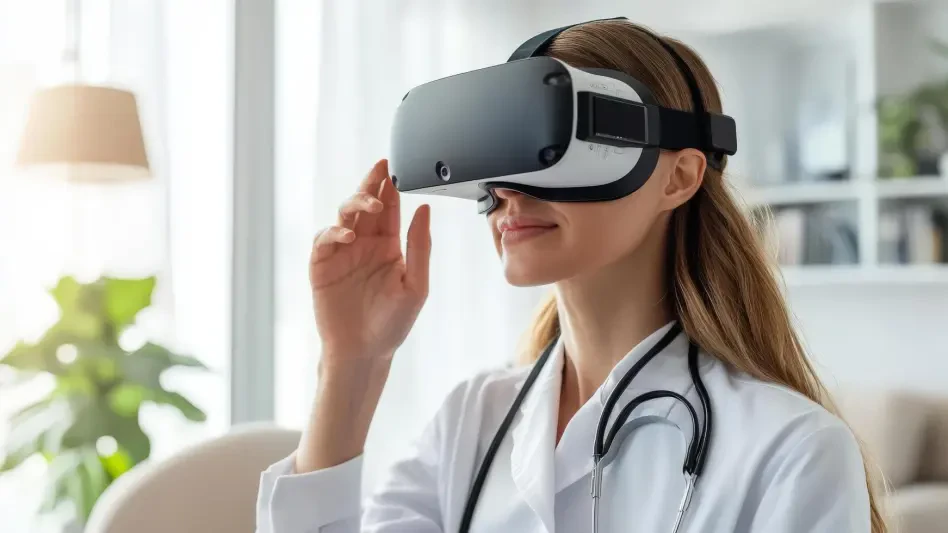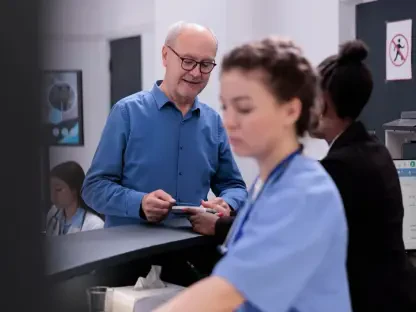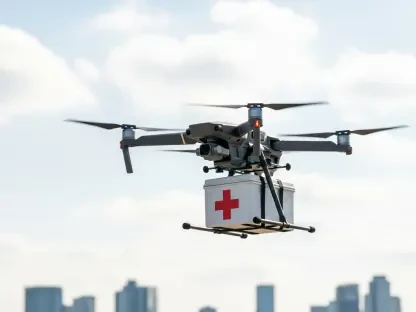Imagine a child facing the daunting prospect of an MRI scan, trapped in a noisy, confined machine while battling fear and the urge to move, a situation that often leads to sedation with its inherent risks and complications. Virtual Reality (VR) technology has emerged as a transformative tool to address this challenge, offering an immersive distraction that can reduce anxiety and the need for sedatives in pediatric MRI settings. This review dives into the capabilities of VR as a non-pharmacological intervention, exploring how it reshapes the experience of diagnostic imaging for children. The focus is on its features, real-world impact, and the potential it holds to redefine patient-centered care in radiology.
Understanding VR’s Role in Pediatric MRI
Virtual Reality technology creates a digital escape for children undergoing MRI scans, immersing them in interactive environments that divert attention from the intimidating aspects of the procedure. By wearing VR headsets, young patients can explore calming landscapes or engage in playful games, effectively masking the loud sounds and tight spaces of the scanner. This approach taps into the psychological power of distraction, helping to ease fear and promote stillness without relying on medication.
Beyond individual patient comfort, VR aligns with a broader shift in healthcare toward minimizing invasive interventions. Hospitals increasingly prioritize solutions that enhance the emotional well-being of children, recognizing that a positive experience can improve compliance and outcomes. VR stands out as a tool that not only addresses immediate procedural challenges but also supports long-term trust in medical settings by making diagnostics less traumatic.
Key Features and Performance of VR in MRI Settings
Immersive Distraction and Anxiety Management
One of the standout features of VR in pediatric MRI is its ability to provide an immersive distraction that significantly reduces anxiety. Tailored virtual worlds, whether a serene beach or an exciting adventure game, engage a child’s senses and shift focus away from the scanner’s unsettling environment. Studies have shown that this psychological diversion often results in lower heart rates and calmer behavior during scans, directly impacting the success of imaging without sedation.
The effectiveness of this feature lies in its capacity to trigger a sense of presence, where the child feels fully absorbed in the virtual setting. This absorption is critical for younger patients who might otherwise struggle with fear or restlessness. As a result, VR often diminishes the need for pharmacological aids, offering a safer alternative that avoids potential side effects like respiratory issues or delayed recovery.
Customization for Diverse Pediatric Needs
Another key strength of VR technology is its adaptability to suit a wide range of ages and anxiety levels among pediatric patients. Content can be adjusted to match developmental stages, with simple animations for toddlers and complex narratives for older children, ensuring relevance and engagement. This flexibility allows clinicians to personalize the experience, addressing specific fears or preferences that vary from one patient to another.
On the technical side, VR systems are designed with user-friendly interfaces and hardware that can be adapted for clinical environments. Feedback from hospital settings highlights the ease of integrating these tools into existing workflows, though proper sizing of headsets for smaller heads remains a consideration. The ability to fine-tune both software and hardware components ensures that VR can meet the unique demands of pediatric care with precision.
Recent Innovations and Advancements
The field of VR for pediatric MRI has seen remarkable progress in recent years, with innovations enhancing both comfort and engagement. Modern headsets are lighter and more adjustable, designed specifically to fit young users while ensuring safety within the magnetic environment of MRI scanners. Improved graphics and audio quality further enrich the virtual experience, making distraction more effective for even the most apprehensive patients.
Integration with pre-procedure programs marks another significant development, where VR is used to familiarize children with the MRI process before the actual scan. These preparatory sessions, often guided by child life specialists, build confidence and reduce surprises on the day of the procedure. Such advancements reflect a growing trend in healthcare to leverage technology for holistic quality improvement, with many hospitals adopting VR as a standard tool in pediatric radiology departments.
Additionally, the push toward non-pharmacological interventions has spurred research into expanding VR content libraries, offering diverse scenarios to cater to cultural and personal preferences. From calming nature simulations to interactive storytelling, these updates aim to keep children engaged for the duration of longer scans. This focus on innovation underscores the commitment to making medical experiences less intimidating for young patients.
Real-World Impact and Case Studies
In practical settings, VR has demonstrated tangible benefits across various pediatric hospitals and clinics. Programs combining VR with support from child life specialists have reported notable decreases in sedation rates, with some facilities achieving reductions of over 50% in routine MRI cases. These initiatives often involve immersive distraction during the scan, coupled with preparatory sessions that help children understand what to expect, fostering a sense of control.
Unique applications have emerged for children with developmental challenges, where VR serves as a bridge to build trust and reduce sensory overload. Case studies reveal instances where tailored virtual environments helped patients with autism spectrum disorder complete scans without distress, a feat previously deemed unlikely without heavy sedation. Such examples highlight VR’s potential to address niche needs within the pediatric population.
The ripple effects extend to family satisfaction and hospital efficiency as well. Parents report feeling more at ease when their children appear less frightened, often praising the technology for transforming a stressful event into a manageable one. Meanwhile, reduced reliance on sedation streamlines workflows by cutting down recovery times and minimizing the need for specialized monitoring, ultimately benefiting clinical operations on a broader scale.
Challenges and Barriers to Adoption
Despite its promise, VR in pediatric MRI faces several hurdles that temper its widespread adoption. High initial costs for hardware and software pose a financial challenge for many healthcare facilities, particularly smaller clinics with limited budgets. Compatibility issues with MRI environments, such as ensuring non-magnetic materials in headsets, also require ongoing attention to prevent safety risks during scans.
Logistical obstacles further complicate integration, as staff training is essential to operate VR systems effectively and guide patients through the experience. Time constraints in busy radiology departments can limit the ability to set up and customize VR for each child, sometimes reducing its feasibility in high-volume settings. These operational challenges demand strategic planning and resource allocation to ensure consistent application.
Patient-specific limitations add another layer of complexity, as VR may not suit very young children or those with sensory sensitivities who find headsets uncomfortable or disorienting. Addressing these gaps through research into alternative distraction methods or modified equipment is crucial. While progress continues, these barriers remind stakeholders that VR, though powerful, is not a universal solution and requires tailored implementation.
Future Potential in Pediatric Radiology
Looking ahead, VR holds immense promise for further revolutionizing pediatric MRI and broader radiology practices. Innovations on the horizon include wireless VR systems that eliminate cumbersome cables, enhancing ease of use within confined scanner spaces. Expanding content libraries with culturally diverse and age-appropriate options could further personalize the experience, ensuring greater accessibility across varied patient demographics.
Integration with other behavioral therapies presents another exciting avenue, where VR could complement techniques like guided imagery or cognitive behavioral approaches to manage anxiety. Such synergies might amplify the technology’s impact, offering a multifaceted strategy to support emotional well-being during medical procedures. Additionally, potential cost reductions through scalable solutions could make VR viable for resource-limited settings in the coming years.
The long-term implications of VR extend to systemic benefits, such as decreased healthcare expenses tied to sedation and improved patient safety by minimizing drug-related risks. As adoption grows from this year and beyond, the technology could foster a cultural shift in how diagnostic imaging is perceived by children and families, building trust and reducing fear. This trajectory points to a future where child-friendly practices become the norm rather than the exception in medical environments.
Final Reflections on VR’s Impact
Reflecting on the evaluation, Virtual Reality proves to be a groundbreaking asset in pediatric MRI, effectively curbing sedation rates and enhancing patient comfort through immersive distraction. Its adaptability and ongoing innovations underscore a significant leap in addressing the emotional needs of young patients during diagnostic imaging. Challenges like cost and logistical barriers do temper its immediate reach, yet the real-world successes in diverse hospital settings affirm its value.
Moving forward, stakeholders should prioritize research into cost-effective VR solutions and expanded training programs to equip staff for seamless integration. Collaborations between technology developers and healthcare providers could accelerate advancements like wireless systems, ensuring broader accessibility. As a next step, pilot programs in varied clinical environments should test scalability, paving the way for standardized protocols that solidify VR’s place in redefining pediatric care.









